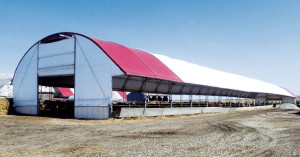Jerome Kuyper is the proud owner of his first Accu-Steel fabric covered building. His original need for the building was to stop the runoff from his open feed yard into a protected creek. Fabric-covered buildings are considered zero runoff facilities, which made Kuyper’s decision easy. The Iowa Beef Expo is where he was first introduced to Accu-Steel. “I had always wanted a building with all steel and no wooden posts, and Accu-Steel could provide that,” Kuyper says. Three days after the introduction at the expo, Accu-Steel was at his property in Northwest Iowa to discuss installation plans.
“I already had a modest tin shed, and the tin got hot in the summer and wore out quickly,” Kuyper explains. Now, five years later Kuyper has two Accu-Steel Cattle Buildings — a 46 ft. by 108 ft. and a 46 ft. by 315 ft. He has also built a 50 ft. by 80 ft. Advantage Structure to house his commodities for his cattle. “Accu-Steel met all of their construction deadlines, and I never worried about my buildings,” he says. “My buildings have not been touched since installation, and I’ve never had a fabric tear. There’s no maintenance to it; I’ve never even had to tighten the cover.” Each of his buildings consists of red barn panels on either end to tie with the color scheme of his farm. “The buildings are eye appealing,” he states.
Profitable Cattle Buildings from Accu-Steel
After the installation of the first cattle building, Kuyper contacted the Iowa Department of Natural Resources (DNR) to assess the original runoff problem. His property now has a clean bill of health from the DNR thanks to the installation of his fabric covered building. Accu-Steel is NRCS (Natural Resources Conservation Service) certified with a pre-engineered code. This allowed Accu-Steel to meet all of the DNR requirements without any paperwork involved, which saved Kuyper roughly $10,000.
Not only did the Accu-Steel building solve the runoff issue, but Kuyper has seen a noticeable difference in the cleanliness, speed to market, and weight of his cattle. Prior to the presence of the new building, steers were gaining 3.2 to 3.8 pounds per day, and now they are gaining 3.5 to 4 pounds per day. Heifers were gaining 2.3 to 2.8 pounds per day, and now they are gaining 2.5 to 3.1 pounds per day. These gains have decreased Kuyper’s time to market by around 30 days.
“I have a very consistent rate of gain and days on feed, which as a custom feeder makes my business more predictable,” he says. “I’m able to practice my animal husbandry business better in a [fabric covered building] more now than ever before,” Kuyper explains.

